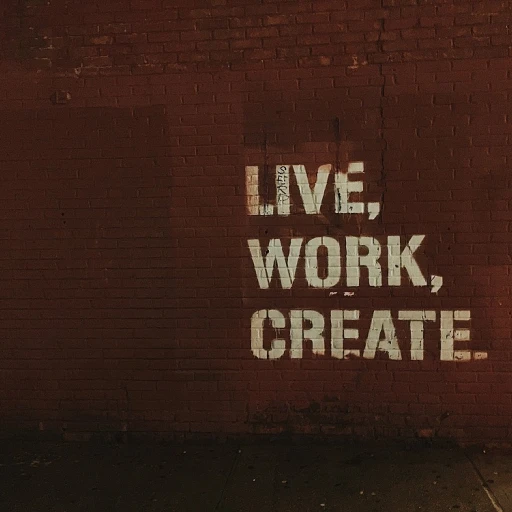
Understanding the essence of employer branding
Decoding the idea behind employer branding
Employer branding, it's more than just a buzzword in today's job market. It's like the heart and soul of what makes your company a place people want to work. Think about Apple or Google; they aren't just brands. They're dreams everyone wants to be part of. But why is that? It's all about how they position themselves.
Why employer branding matters more than ever
In a data-driven age, where everyone googles everything, transparency is key. According to Glassdoor, 86% of people research company reviews and ratings before committing to an interview. Knowing this, your brand needs to be irresistible and reliable at first glance.
Critical factors shaping employer brand
So, what really molds a company's reputation? It's a mix of company culture, values, employee beliefs, and even management styles. The 2020 LinkedIn Employer Branding Survey showed that 72% of candidates will share bad experiences with others, potentially affecting your talent pool. It's crucial to leverage these insights when sculpting a brand message that's not just heard but felt.
Who's the brains behind the best employer brands?
Folks like Brian Kropp, Chief of Research at Gartner, have emphasized how fostering a culture of constant feedback can elevate your brand. His insight, "Employees today need to feel heard and valued; it’s what separates successful companies from the rest," holds incredible weight.
Real-world examples to inspire you
Take Starbucks, for example. They've done a brilliant job in making their employees, or "partners," feel part of a larger mission. Through their 'To Be Welcoming' initiative, they’ve directly impacted their employee satisfaction, leading to better customer service.
Key components of successful employer branding campaigns
Attracting the right talent through strong values
First off, a powerful employer branding campaign starts with identifying and promoting your company's core values. Research shows that companies with solid, well-communicated values see a 27% reduction in employee turnover (Glassdoor, 2021). Martine Ferland, president and CEO of Mercer, shares, "Employees today are drawn to companies that stand for something meaningful, something bigger than just profits."
Crafting a compelling employee value proposition
A well-articulated employee value proposition (EVP) is another cornerstone. According to Gartner, a compelling EVP can boost new hire commitment by 29% (Gartner, 2020). This goes beyond paychecks; it encompasses the unique benefits and growth opportunities you offer. Netflix, for example, promotes an "unlimited vacation policy" to emphasize work-life balance, setting a strong EVP for potential recruits.
Investing in people-centric marketing
People-centric marketing involves creating relatable content that resonates with your target audience. A LinkedIn study found that companies using human-centric branding experienced 33% more engagement on their posts (LinkedIn, 2022). This could include showcasing stories of employee achievements, behind-the-scenes footage, or day-in-the-life videos that make your company culture palpable.
Leveraging employer branding through impactful storytelling
Stories are powerful. Narratives about your company's mission, successes, and even failures, can foster a deeper connection and emotional resonance. According to a survey by Edelman, 52% of employees look to company stories for a sense of belonging (Edelman Trust Barometer, 2020). IBM is a notable example, sharing numerous stories about how their technology helps solve real-world problems, thus reinforcing their employer brand.
Aligning branding campaigns with DEI initiatives
Diversity, equity, and inclusion (DEI) play crucial roles in modern employer branding campaigns. Companies with robust DEI programs outperform their peers by 35% in innovation revenue, based on a study by the Boston Consulting Group (BCG, 2018). Salesforce has excelled in this realm, launching campaigns that highlight their commitment to inclusive workplaces, which significantly boosts their employer brand.
Designing and refining authentic brand experiences
Authenticity is paramount. Potential hires can easily spot inauthentic claims. Data from PwC indicates that 48% of candidates will bypass a role if they perceive the company's branding as inauthentic (PwC, 2021). Authenticity should be mirrored in interviews, onboarding processes, and everyday worklife to foster a strong, attractive employer brand.
Showcasing growth and development opportunities
Promoting ongoing learning and development can set your employer brand apart. A report by LinkedIn Learning showed that 94% of employees would stay with a company longer if it invested in their career development (LinkedIn Learning, 2019). Companies like Google and Amazon have substantial learning and development programs that they actively market, ensuring they attract ambitious talent looking to grow their careers.
Case study: Top-tier companies nailing employer branding
Employee testimonials: a powerful tool for employer branding
Diving into the real world, let's talk about some big names killing it with employer branding. Everyone's textin' about it, Tweetin' about it, and Sharin' them LinkedIns. But what's really behind those polished campaigns? Employee voices, that's what. When your people speak up, you listen. It's the silent treat most companies overlook but not these top dogs.
How Google's open culture sparks curiosity
Google - ever heard of 'em? Yeah, me too. Their employer branding? On point. The secret weapon? Their open culture. Employees rave about the freedom to explore. How do we know? Transparent testimonials. Check Glassdoor or any career site, and you'll see a 4.5-star rating from thousands of happy campers (Glassdoor.com). Not just talk - Google's annual reports confirm their low turnover rate, keeping those genius brains right where they belong.
Starbucks: brewing community and inclusivity
Next up, Starbucks. Famous for more than just coffee. Their employer branding heavily leans on social inclusivity. With a 78% positive rating on Indeed from over 46,000 reviews (Indeed.com), it's clear their blend of community-focused policies and employee stories brew well together. Real stories of career growth and community support flood their media.
The honest truth behind Elon Musk's SpaceX
SpaceX – Elon Musk's brainchild. It's not all rockets and Mars, believe it or not. Employee reviews flatter the high-intensity environment, challenging yet rewarding. Glassdoor shows a steady 4-star rating from around 3,000 reviews (Glassdoor.com) - that's the rocket fuel for their branding. Real testimonials shed light on growth opportunities, making SpaceX a prime example of employee-driven branding.
Netflix: storytelling isn’t just for the screen
And Netflix? The storytelling kings use the same magic for their employer branding. Employee testimonials highlight a culture promoting creativity, evident from their 4.3-star rating on Glassdoor (Glassdoor.com). Behind the screens, it's the open feedback loops and unlimited vacation policy that take the spotlight in testimonials.
Accenture's strategy: fostering innovation
Accenture shines by emphasizing innovation in employee experiences. With a 4.1-star rating on Indeed (Indeed.com) by nearly 20,000 employees, their strategy seems to be working just fine. They leverage employee voices in their campaigns to demonstrate a commitment to constant innovation, ensuring employees feel valued and heard.
Real talk: what makes these campaigns tick?
So why is this working? It's real people sharing real stories. The data confirms it. The high ratings, the countless testimonials – it all ties back to genuine experiences. Employee voices aren't just fluff; they're the lifeblood of successful employer branding. By weaving authentic testimonials into their narrative, these companies don't just show off – they genuinely connect with talent, bolstering their brand.
Leveraging social media in employer branding
Maximizing reach and engagement
Social media isn't just for selfies and foodie pics; it’s a goldmine for employer branding. Platforms like LinkedIn, Instagram, and even TikTok have become central to showcasing what makes working at your company unique. According to a LinkedIn research, 61% of professionals follow companies on social media to stay updated on job openings, and 49% do so for content about company culture.
Example: Adobe’s Instagram account features its employees under the hashtag #AdobeLife, generating genuine, behind-the-scenes content showcasing their vibrant culture.
Expert opinions
According to employer branding expert Gazal Kaur, “Social media can capture the raw and authentic voice of your employees, which in turn strengthens your employer brand. It’s about building narratives that potential hires can visualize themselves in.”
The power of videos
Video content reigns supreme on social media. Companies that share employee testimonials, day-in-the-life scenarios, and team activities in video format receive higher engagement rates. The State of Video Marketing 2023 by HubSpot reported that 78% of people watch online videos every week, and 55% view online videos every day. This level of engagement is hard to ignore.
Effective campaigns
Consider the viral campaign by Heineken ‘Go Places.’ Through an interactive video journey, they brilliantly showcased their company culture and values, resulting in a 300% increase in applications the following year.
Measuring success on social media
Measuring the success of social media in employer branding isn’t just about follow counts and likes. Metrics such as engagement rates, comments, and shares offer better insights into how your audience is connecting with your content. Analyzing share-of-voice among competitors can also reveal where you stand in the industry.
Incorporating user-generated content, such as employee posts and stories, adds an extra layer of authenticity, encouraging others to share their experiences too, widening your outreach organically.
The role of employee testimonials in employer branding
Employee testimonials as the heartbeat of employer branding
Employee testimonials offer a personal touch that no other element of employer branding can quite match. These stories come straight from the source—your employees. And there's a good reason why they are the linchpin in successful employer branding campaigns.
Let's look at the numbers. According to Glassdoor, 70% of people look to company reviews before making career decisions. That's huge! When potential employees see current staff singing praises about your company, it builds trust. It’s not just marketing fluff—this is real talk from real folks.
Trust and authenticity: Why employees' voices matter
The true magic lies in authenticity. Employees offer insights into your company that polished ads can't. Their stories of growth, culture, and daily work life resonate deeply with prospects.
Take Salesforce, for example. They frequently feature employee stories across various platforms, and the result? They consistently land on “Best Places to Work” lists. And it’s not by happenstance, rather a strategic move of leveraging genuine testimonials.
Strategies for integrating employee testimonials
- Video Testimonials: Short, engaging clips of employees sharing their experiences can work wonders. According to Biteable, video content is 1200% more likely to be shared than text and images combined.
- Social Media Posts: Encourage your team to share their journey on platforms like LinkedIn or Instagram. Employee-generated content adds a layer of credibility.
- Dedicated Testimonial Pages: Create sections on your career site dedicated to these stories. IBM has a great example where they showcase employees from different departments and regions.
Real-world example: Adobe
Adobe really nails this. They run a campaign called #AdobeLife, where employees share their experiences on social media. This user-generated content paints a vivid, trustworthy picture of their workplace culture. As a result, they have seen an uptick in applicant quality and diversity.
Potential pitfalls
There are some cautions to heed. Avoid scripting or forcing testimonials. Authenticity reigns supreme, and any hint of coercion can backfire spectacularly. Moreover, continuous monitoring ensures the stories remain fresh and are being used effectively without becoming stale or repetitive.
Expert insights
William Tincup, President of RecruitingDaily, said, “Employee testimonials are invaluable. They humanize your brand and act as social proof.” And the stats back him up. According to LinkedIn, candidates trust employees’ words three times more than the company's in identifying job aspects worth knowing.
Metrics to measure the success of employer branding campaigns
Why measuring success matters
Employer branding ain't just about crafting a pretty picture; it's about creating long-term impact. The only way to know if your efforts pay off is to measure everything. According to LinkedIn's Global Recruiting Trends, a whopping 67% of employers consider their employer brand a top priority. So, how do you know you're on the right track?
Key metrics you should track
Start with understanding what to measure. Engagement metrics, application rates, and employee retention are some top pointers. Shrm.org states that companies with strong employer brands see a 50% more qualified applicant pool. Here’s a list to get you started:
- Employee engagement scores: Measured through surveys and pulse checks.
- Application volume and quality: Are you attracting suitable candidates?
- Retention rates: Are employees sticking around longer?
- Employee Net Promoter Score (eNPS): How likely are your employees to recommend your company?
By keeping a close eye on these, you can fine-tune your strategies for better results.
Real-life examples: Who's doing it right?
Let's talk heavy hitters. Take Google, for instance. They consistently rank at the top of employers' lists due to their innovative approach to metrics. Google uses a mix of employee feedback and analytical data to track their employer brand's health. Research from Gallup indicates that engaged workplaces have 41% lower absenteeism, and Google's focus on this metric shows it pays off.
Critical tools to use
Can't measure what you can't track, right? Tools like Culture Amp and Qualtrics make capturing employee sentiment a breeze. Forbes recommends using comprehensive analytics platforms that can integrate with your HR system, offering a 360-degree view of employee engagement and satisfaction.
Expert insights on best practices
Dr. John Sullivan, a well-known HR thought leader, suggests putting metrics at the core of every employer branding initiative. According to him, “You can’t manage what you don’t measure.” Simple, yet profound.
Controversies in measuring success
It's not all smooth sailing, though. Some argue that metrics like eNPS can be flawed, unable to give a full picture of employee sentiment. Critics from Harvard Business Review argue that relying solely on quantifiable data may overshadow the qualitative aspects of a brand, like cultural fit and employee happiness.
Future trends in employer branding campaigns
Interactive employee experiences
Creating engaging, interactive experiences for employees is quickly becoming a priority for companies wanting to stay ahead. According to a 2023 Deloitte report, over 60% of companies now use gamification within their workplaces to enhance employee engagement and retention. Spotify, for instance, has incorporated trivia games and interactive platforms in their onboarding process, making new hires feel more connected and enthusiastic right from the start.
AI and machine learning in employer branding
The adoption of AI and machine learning technologies is revolutionizing how companies craft their employer brands. A LinkedIn study highlighted that 35% of HR departments are using AI to streamline recruitment processes. Tools like HireVue utilize AI to analyze video interviews, ensuring a more unbiased selection process while enhancing the candidate experience. It has helped companies like Unilever reduce their hiring time by 75%.
Personalized employer branding
Personalization is now at the core of employer branding strategies. A 2022 report from Glassdoor indicates that 71% of job seekers consider tailored communication from potential employers as a major factor in their job decision-making process. Deloitte has successfully implemented personalized communication strategies by sending targeted content and updates to employees and candidates based on their interests and career goals.
Focus on mental health and well-being
The emphasis on mental health and well-being has never been more significant. A Gallup poll revealed that around 76% of employees believe their employers should better support their mental health. Companies like Microsoft have rolled out various mental health programs and resources, which include regular company-wide mental health days and access to wellness apps like Headspace.
Remote work and flexible schedules
With remote and hybrid work models becoming the norm, companies are rethinking their employer branding approaches. An Owl Labs study in 2022 found that remote workers were 22% happier than those who worked on-site full-time. In response, Uber has introduced a 'work-from-anywhere' policy, allowing employees to choose their work environment, which has significantly boosted employee satisfaction and retention rates.
The rise of purpose-driven branding
Purpose-driven employer branding is gaining traction as employees seek greater meaning in their work. A 2022 Edelman report showed that 58% of employees would leave their job for one that aligns more closely with their personal values. Companies like Patagonia are leading the charge, with clear commitments to environmental sustainability deeply embedded in their employer brand, attracting like-minded talent.
Data-driven strategies for continuous improvement
Leveraging data analytics to refine employer branding is set to become the standard. According to a 2023 Gartner report, 48% of organizations are using advanced analytics to measure the effectiveness of their employer branding campaigns. Shopify, for example, continually analyzes engagement data from their internal communication platforms to adjust their branding strategies and ensure they resonate with their workforce.
These trends highlight the innovative directions in which employer branding is headed. Staying attuned to these developments is essential for any company aiming to attract and retain top talent in an increasingly competitive market.
Implementing continuous improvement in employer branding
Learning from the best
When it comes to employer branding, it's not a one-and-done deal. Continuous improvement is key. Look at companies like Google and Salesforce. They constantly refine their employer branding strategies, proven by their ability to retain top talent and stay ahead in the race. It's about learning from your own experiences and the industry's best practices.
Employee feedback loops
Never underestimate the power of employee feedback. Create channels for employees to share their thoughts on the company’s culture, communication, and brand perception. Tools like Officevibe and TINYpulse can help gather valuable insights. Then, use this data to make informed adjustments. According to a TINYpulse study, companies that regularly collect feedback saw a 14% decrease in turnover rate.
Benchmark your progress
Regularly benchmark your employer branding performance. Tools like Glassdoor's Employer Center and LinkedIn Talent Solutions can provide vital metrics. For example, a LinkedIn report highlighted that companies with strong employer brands see a 43% decrease in cost per hire. Making data-driven improvements ensures you’re always moving in the right direction.
Leverage social media analytics
Social media is not just for initial engagement; it’s also crucial for continuous improvement. Monitor metrics like engagement rates, follower growth, and social sentiment. Analytics tools like Hootsuite and Sprout Social can help gauge the effectiveness of your social media campaigns. According to Sprout Social, businesses saw a 6x return on their investment with well-optimized social media strategies.
Training and development programs
Invest in regular training programs for your HR and marketing teams. This ensures they are up-to-date with the latest trends and strategies. SHRM reports that companies with continuous training programs experienced a 218% higher income per employee than those with minimal training.
Adaptive strategies
The business environment is in constant flux, and so should your employer branding strategies. Be prepared to pivot and adapt. Use tools like SWOT analysis to regularly assess your strengths, weaknesses, opportunities, and threats. Harvard Business Review suggests that adaptive companies grow sales 5-10% faster and deliver 15-25% higher total shareholder returns over time.
By continuously improving your employer branding, you ensure that your company remains attractive to top talent, reverberating across all aspects of your organization.



